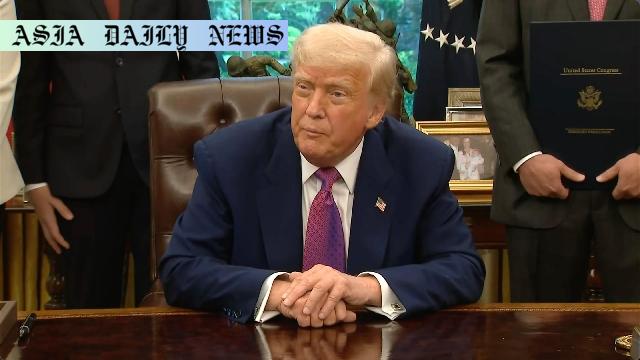Tariffs remain a central economic policy, with a baseline 10% levy on all nations; key exceptions and details revealed in US trade strategy.
The US is maintaining a 10% baseline tariff on all countries as a significant trade strategy.
President Trump highlighted upcoming trade deals and stricter policies on China.
A recent trade agreement with Britain reflects specific tariff adjustments.
White House emphasizes no unilateral tariff decisions on China without compromises.

The Significance of the U.S. 10% Baseline Tariff
The introduction of a 10% baseline tariff policy by the United States underscores the Trump administration’s resolve to streamline economic strategies across international trade relationships. Taking effect on April 5, the tariff represents a foundational economic measure aimed at stabilizing domestic industries amidst global competition. President Trump has made it clear that while exceptions might arise, maintaining this threshold is crucial for maintaining equity and strengthening America’s position in trade negotiations.
This policy follows a series of tariffs aimed at broader objectives, such as protecting American manufacturing jobs and balancing trade deficits. The decision builds consistency, ensuring a level playing ground where all countries entering agreements with the U.S. begin negotiations on equal terms. Notably, this approach has already impacted recent dealings, including adjustments in high-profile trade pacts like the U.K. agreement. The shift from a 25% levy to the 10% minimum for British-made cars reflects the adaptability embedded within the policy framework when conditions are met.
Future Trade Deals and Anticipated Developments
President Trump’s announcement regarding expectations of four-to-five imminent trade deals reveals his administration’s proactive stance in expanding the United States’ economic outreach globally. Trade deals with economically significant nations hint at attempts to optimize benefits under the tariff system while fostering partnerships on mutual terms. The consistency of the 10% tariff serves as a strategic component to limit disparities when new agreements are pursued.
One noteworthy aspect of Trump’s policy is his suggestion of significantly high tariffs for China. Stating that an “80% tariff seems right,” Trump indicated possible revisions to the prevailing 145% surcharge on Chinese imports. However, both his remarks and the comments from the White House Press Secretary, Karoline Leavitt, suggest a cautious approach, contingent on concessions from Beijing. This measured stance reflects the administration’s dual focus on assertiveness and pragmatism in handling a historically volatile trade relationship with China.
Implications for Global Trade and U.S. Economy
While forging new trade deals is a priority, it’s vital to analyze the broader implications of such an assertive tariff policy. In maintaining a significant levy on all nations, the policy sends a clear message of reform to foreign markets heavily reliant on exporting goods to the United States. With cars from the U.K. now enjoying reduced tariffs after negotiations, other exporters may be incentivized to seek tailored agreements within this established framework.
Furthermore, by effectively maintaining protections for domestic markets and labor, the policy has positioned itself as a contentious but essential strategy in an increasingly competitive global economy. However, questions remain regarding how this tariff policy will navigate potential diplomatic hurdles, especially as nations resist such aggressive impositions or seek retaliatory tariffs. Maintaining this balance will require adept policymaking that not only addresses U.S. interests but does so without eroding valuable partnerships.
Commentary
An Insightful Analysis of the U.S. Tariff Policy
The retention of a 10% baseline tariff policy symbolizes a bold and calculated move by President Trump. This strategy appears rooted in economic protectionism, aiming to balance trade relationships while safeguarding domestic interests. While some may critique the underlying protectionist tone, the policy highlights a shift toward reinforcing America’s economic independence and resilience in highly competitive global markets.
Potential Advantages in Economic Partnerships
One notable advantage of maintaining a consistent tariff baseline is the opportunity for predictability in trade agreements. Foreign producers and governments engaging with the U.S. now have a clear understanding of foundational trade terms, enabling streamlined negotiations. For example, the recently adjusted car tariff for British imports demonstrates how the U.S. has skillfully leveraged the baseline tariff system to secure specific benefits, fostering mutual value and compliance in bilateral trade agreements.
Challenges with Aggressive Positions
However, the policy’s implications aren’t devoid of challenges. A proposed 80% tariff on China, though indicative of the Trump administration’s hard-line approach to trade relations with Beijing, underscores potential risks of market friction. Such sweeping measures might invite retaliatory actions or strain diplomatic relationships, further complicating America’s foreign trade strategies. Balancing assertiveness with diplomacy will be critical if such policies are to yield sustainable outcomes.
Conclusion: A Positive or Contentious Strategy?
Ultimately, the U.S. tariff policy reflects a resolute commitment to reshaping the global trade narrative in favor of American interests. Whether this strategy proves beneficial long-term will depend on its ability to foster equitable trade terms while avoiding unnecessary global trade conflicts. Nonetheless, it marks a deliberate and strategic shift in economic policymaking that places national interests as a top priority.


